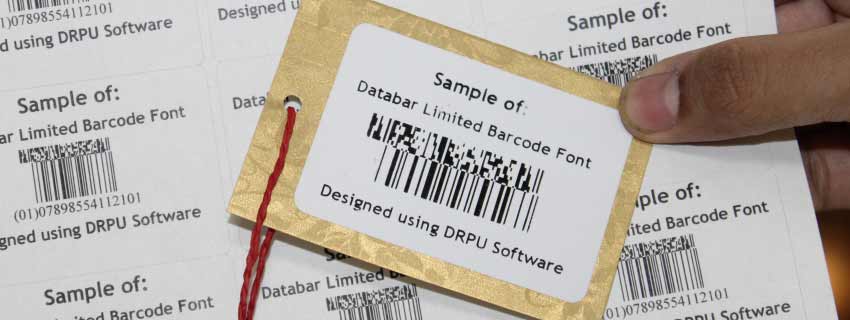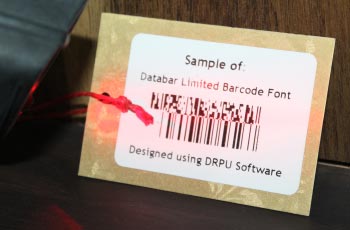Databar Limited Barcode: Generating, Printing, Scanning, and Limitations

Generating a Databar Limited barcode involves creating the barcode image and encoding the necessary data. Here are the steps to generate a Databar Limited barcode:
-
►
Step 1: Choose a Barcode Generator
There are several barcode generator tools available online. You can choose one that is easy to use and generates high-quality barcodes.
-
►
Step 2: Select the Databar Limited Barcode Type
Once you have selected a barcode generator, choose the Databar Limited barcode type from the list of available barcode types.
-
►
Step 3: Enter the Data
Enter the data you want to encode in the barcode. The data should be in the format required for the barcode type. For Databar Limited barcode, the data should be a GTIN-12 or GTIN-14 number.
-
►
Step 4: Choose the Barcode Options
Choose the options for the barcode, such as barcode size, resolution, and color. Ensure that the barcode size is appropriate for the intended use of the barcode.
-
►
Step 5: Generate the Barcode
Click on the generate button to create the Databar Limited barcode image. You can then save the image to your computer or print it directly.
-
►
Step 6: Verify the Barcode
Before using the barcode, ensure that it is scannable by testing it with a barcode scanner
To generate a Databar Limited barcode, special software is required that can create the barcode pattern. The software typically allows the user to input the data that needs to be encoded and generates the barcode image that can be printed. There are also online tools available that can generate Databar Limited barcodes for free.
Overall, generating a Databar Limited barcode is a relatively simple process, and there are many online tools available that can help you create the barcode quickly and easily.
Databar Limited Barcode: Printing
Printing a Databar Limited barcode involves a few important steps to ensure accuracy and readability of the barcode. Printing Data bar Limited barcodes requires a high-resolution printer that can produce sharp and clear images. The barcode must be printed at a size that is large enough to be read by scanners but small enough to fit on the product. The printed barcode must also be positioned correctly on the product to ensure that it can be scanned by the scanner.
Here are the general steps for printing a Databar Limited barcode:
-
Choose a Printing Technology:
There are several printing technologies available to print barcodes, such as thermal transfer, direct thermal, inkjet, and laser printing. Choose a technology based on the requirements of the application, the type of material to be printed on, and the volume of printing required.
-
Choose a Barcode Generator:
Choose the appropriate barcode symbology: Databar Limited barcode can be printed in various symbologies, such as DataBar-14, DataBar Limited, DataBar Expanded, and DataBar Stacked. Choose the symbology based on the type of data to be encoded and the size of the barcode.
-
Enter the Data:
Enter the data to be encoded into the barcode in the software. The data may include product codes, serial numbers, batch numbers, and other relevant information related to the product.
-
Adjust the Size and Dimensions:
Adjust the size and dimensions of the barcode to ensure that it fits the label or tag properly. The size of the barcode will depend on the amount of data encoded and the printing technology used.
-
Choose the Background and Foreground Colors:
Choose the background and foreground colors that will provide the best contrast for optimal readability of the barcode.
-
Print the Barcode:
Once all the settings are adjusted, print the barcode using the selected printing technology. Ensure that the printer is calibrated properly to ensure the barcode is printed with the highest quality.
-
Verify the Barcode:
Verify the barcode using a barcode scanner to ensure that it is readable and contains the correct information.
In summary, to print a Databar Limited barcode, you need to choose the printing technology, select the barcode generator software, choose the appropriate symbology, enter the data, adjust the size and dimensions, choose the background and foreground colors, print the barcode and verify its accuracy using a barcode scanner.
Databar Limited Barcode: Scanning
Overview of DataBar Limited Barcodes
DataBar Limited barcodes are a type of linear barcode that was developed by GS1, a global organization that develops standards for supply chain management. The DataBar Limited barcode is a two-dimensional symbology that can encode up to 74 characters of data. The scanner then converts the image into a digital signal that can be decoded to retrieve the encoded data.
Scanning a Databar Limited Barcode
To scan a DataBar Limited barcode, you will need a barcode scanner that is capable of reading the barcode format. There are several types of barcode scanners available, including handheld scanners, fixed scanners, and mobile scanners. Databar Limited barcodes can be scanned by a variety of devices, including handheld scanners, barcode readers, and smart phones. The scanner must be capable of reading the barcode pattern, which is usually indicated in the scanner's documentation. The type of scanner you choose will depend on your application and scanning requirements.

-
Handheld Barcode Scanners
Handheld barcode scanners are the most common type of barcode scanner used for scanning DataBar Limited barcodes. These scanners are portable and can be used to scan barcodes from a distance. Handheld scanners are available in two types: laser scanners and image scanners.
-
Laser scanners:
Laser scanners use a laser beam to capture the image of the barcode. The scanner emits a beam of light that reflects off the barcode and is detected by a sensor in the scanner. The scanner then converts the image into a digital signal that can be decoded to retrieve the encoded data.
-
Image scanners:
Image scanners use a camera to capture the image of the barcode. The scanner captures a digital image of the barcode, which is then processed to retrieve the encoded data. Image scanners are capable of reading 2D barcodes, such as QR codes, in addition to DataBar Limited barcodes.
-
Fixed Barcode Scanners
Fixed barcode scanners are designed to be mounted on a surface and are used in applications where the barcode needs to be scanned automatically. These scanners are commonly used in retail and logistics applications. Fixed scanners use a laser or camera to capture the image of the barcode. The scanner then converts the image into a digital signal that can be decoded to retrieve the encoded data.
-
Mobile Barcode Scanners
Mobile barcode scanners are handheld scanners that are integrated with a mobile device such as a smartphone or tablet. These scanners are used in applications where mobility is required, such as inventory management and order fulfillment. Mobile scanners use a camera to capture the image of the barcode. The scanner then converts the image into a digital signal that can be decoded to retrieve the encoded data.
Download and Install Barcode Software
The Limitations of using a Databar Limited Barcode
Databar Limited, also known as Reduced Space Symbology (RSS), is a type of two-dimensional (2D) barcode that has specific advantages and limitations when compared to other barcode types. In this response, we will discuss the limitations of using a Databar Limited barcode in detail.
-
Limited Data Capacity:
One of the most significant limitations of Databar Limited is its limited data capacity. While it can encode more information than a traditional one-dimensional (1D) barcode, it has a lower data capacity than other 2D barcode types like QR codes and Data Matrix codes. This limitation restricts its use in situations where a higher amount of data needs to be encoded.
-
Limited Scanning Range
Another limitation of Databar Limited is its limited scanning range. This barcode type requires a specific scanner designed to read its unique layout and structure. As a result, it has a smaller scanning range than traditional 1D barcodes that can be read by most barcode scanners. This limitation restricts its use in situations where the barcode needs to be read from a distance or in challenging environments.
-
Limited Support
Databar Limited is not as widely supported as other barcode types. This means that it may not be compatible with some systems, software, or hardware. As a result, its use may be restricted in some industries or applications where compatibility is essential.
-
Limited Readability
Databar Limited can be difficult to read under certain circumstances. For example, if the barcode is printed too small, has low contrast with its background, or is damaged or smudged, it may not be readable. This limitation can lead to errors in data capture or result in additional time and effort spent trying to read the barcode correctly.
-
Limited Use Cases:
Finally, Databar Limited is designed for specific use cases and industries. Its use may be limited in situations where a different barcode type is more suitable. For example, QR codes may be more appropriate for marketing campaigns, while Data Matrix codes may be better suited for tracking and inventory management.
-
Cost:
Implementing barcode systems can be expensive, especially for small businesses. To address this issue, it is important to evaluate the benefits and costs of the system and determine if it is cost-effective.
-
Staff Training:
Barcode systems require trained personnel to operate and maintain them. Providing adequate training to the staff is essential to ensure the system's smooth operation and to minimize errors.
Overall, while Databar Limited offers specific advantages, it is essential to consider its limitations when determining whether it is the right barcode type for a particular use case.
Last Updated On: